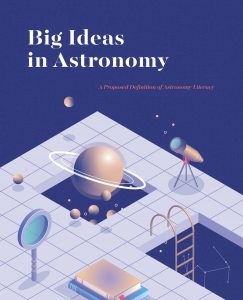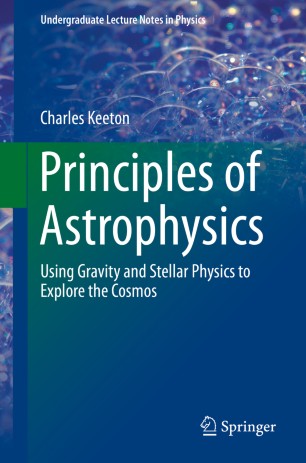
Essential Astrophysics is a book to learn or teach from, as well as a fundamental reference volume for anyone interested in astronomy and astrophysics. It presents astrophysics from basic principles without requiring any previous study of astronomy or astrophysics. It serves as a comprehensive introductory text, which takes the student through the field of astrophysics in lecture-sized chapters of basic physical principles applied to the cosmos.
This one-semester overview will be enjoyed by undergraduate students with an interest in the physical sciences, such as astronomy, chemistry, engineering or physics, as well as by any curious student interested in learning about our celestial science. The mathematics required for understanding the text is on the level of simple algebra, for that is all that is needed to describe the fundamental principles. The text is of sufficient breadth and depth to prepare the interested student for more advanced specialized courses in the future. Astronomical examples are provided throughout the text, to reinforce the basic concepts and physics, and to demonstrate the use of the relevant formulae. In this way, the student learns to apply the fundamental equations and principles to cosmic objects and situations.
All of the examples are solved with the rough accuracy needed to portray the basic result. Astronomical and physical constants and units as well as the most fundamental equations can be found in the appendix. Essential Astrophysics goes beyond the typical textbook by including references to the seminal papers in the field, with further reference to recent applications, results, or specialized literature.
There are fifty set-aside focus elements that enhance and augment the discussion with fascinating details. They include the intriguing historical development of particular topics and provide further astrophysics equations or equations for other topics.
Clique aqui para acessar o livro.
Summary
1 Observing the Universe
1.1 What Do Astronomers and Astrophysicists Do?
1.2 Our Place on Earth
1.3 Location in the Sky
1.4 Measuring Angle and Size
1.5 The Locations of the Stars are Slowly Changing
1.6 What Time is It?
1.7 Telling Time by the Stars
1.8 Optical Telescopes Observe Visible Light
1.9 Telescopes that Detect Invisible Radiation
1.10 Units Used by Astronomers and Astrophysicists
1.11 Physical Constants
2 Radiation
2.1 Electromagnetic Waves
2.2 The Electromagnetic Spectrum
2.3 Moving Perspectives
2.4 Thermal (Blackbody) Radiation
2.5 How Far Away is the Sun, and How Bright, Big and Hot is it?
2.5.1 Distance of the Sun
2.5.2 How Big is the Sun?
2.5.3 The Unit of Energy
2.5.4 The Sun’s Luminosity
2.5.5 Taking the Sun’s Temperature
2.5.6 How Hot are the Planets?
2.6 The Energy of Light
2.7 Radiation Scattering and Transfer
2.7.1 Why is the Sky Blue and the Sunsets Red?
2.7.2 Rayleigh Scattering
2.7.3 Thomson and Compton Scattering
2.7.4 Radiation Transfer
3 Gravity
3.1 Ceaseless, Repetitive Paths Across the Sky
3.2 Universal Gravitational Attraction
3.3 Mass of the Sun
3.4 Tidal Effects
3.4.1 The Ocean Tides
3.4.2 Tidal Locking into Synchronous Rotation
3.4.3 The Days are Getting Longer
3.4.4 The Moon is Moving Away from the Earth
3.4.5 A Planet’s Differential Gravitational Attraction Accounts for Planetary Rings
3.5 What Causes Gravity?
4 Cosmic Motion
4.1 Motion Opposes Gravity
4.1.1 Everything Moves
4.1.2 Escape Speed
4.2 Orbital Motion
4.3 The Moving Stars
4.3.1 Are the Stars Moving?
4.3.2 Components of Stellar Velocity
4.3.3 Proper Motion
4.3.4 Radial Velocity
4.3.5 Observed Proper Motions of Stars
4.3.6 Motions in Star Clusters
4.3.7 Runaway Stars
4.4 Cosmic Rotation
4.4.1 Unexpected Planetary Rotation
4.4.2 The Sun’s Differential Rotation
4.4.3 Stellar Rotation and Age
5 Moving Particles
5.1 Elementary Constituents of Matter
5.2 Heat, Temperature, and Speed
5.2.1 Where Does Heat Come From?
5.2.2 Thermal Velocity
5.2.3 Collisions
5.2.4 The Distribution of Speeds
5.3 Molecules in Planetary Atmospheres
5.4 Gas Pressure
5.4.1 What Keeps Our Atmosphere Up?
5.4.2 The Ideal Gas Law
5.4.3 The Earth’s Sun-Layered Atmosphere
5.4.4 Pressure, Temperature, and Density Inside the Sun
5.5 Plasma
5.5.1 Ionized Gas
5.5.2 Plasma Oscillations and the Plasma Frequency
5.5.3 Atoms are Torn Apart into Plasma Within the Sun
5.6 Sound Waves and Magnetic Waves
5.6.1 Sound Waves
5.6.2 Magnetic Waves
6 Detecting Atoms in Stars
6.1 What is the Sun Made Out Of?
6.2 Quantization of Atomic Systems
6.3 Some Atoms are Excited Out of Their Lowest-Energy Ground State
6.4 Ionization and Element Abundance in the Sun and Other Stars
6.5 Wavelengths and Shapes of Spectral Lines
6.5.1 Radial Motion Produces a Wavelength Shift
6.5.2 Gravitational Redshift
6.5.3 Thermal Motion Broadens Spectral Lines
6.5.4 Rotation or Expansion of the Radiating Source can Broaden Spectral Lines
6.5.5 Curve of Growth
6.5.6 Magnetic Fields Split Spectral Lines
7 Transmutation of the Elements
7.1 The Electron, X-rays and Radium
7.2 Radioactivity
7.3 Tunneling Out of the Atomic Nucleus
7.4 The Electron and the Neutrino
7.5 Cosmic Rays
7.6 Nuclear Transformation by Bombardment
8 What Makes the Sun Shine?
8.1 Can Gravitational Contraction Supply the Sun’s Luminosity?
8.2 How Hot is the Center of the Sun?
8.3 Nuclear Fusion Reactions in the Sun’s Core
8.3.1 Mass Lost is Energy Gained
8.3.2 Understanding Thermonuclear Reactions
8.3.3 Hydrogen Burning
8.3.4 Why Doesn’t the Sun Blow Up?
8.4 The Mystery of Solar Neutrinos
8.4.1 The Elusive Neutrino
8.4.2 Solar Neutrino Detectors Buried Deep Underground
8.4.3 Solving the Solar Neutrino Problem
8.5 How the Energy Gets Out
8.6 The Faint-Young-Sun Paradox
8.7 The Sun’s Destiny
9 The Extended Solar Atmosphere
9.1 Hot, Volatile, Magnetized Gas
9.1.1 The Million-Degree Solar Corona
9.1.2 Varying Sunspots and Ever-Changing Magnetic Fields
9.1.3 Coronal Loops
9.1.4 What Heats the Corona?
9.1.5 Coronal Holes
9.2 The Sun’s Varying Winds
9.2.1 The Expanding Sun Envelops the Earth
9.2.2 Properties of the Solar Wind
9.2.3 Where Do the Two Solar Winds Come From?
9.2.4 Where Does the Solar Wind End?
9.3 Explosions on the Sun
9.3.1 Solar Flares
9.3.2 Coronal Mass Ejections
9.4 Space Weather
9.4.1 Earth’s Protective Magnetosphere
9.4.2 Trapped Particles
9.4.3 Earth’s Magnetic Storms
9.4.4 Solar Explosions Threaten Humans in Outer Space
9.4.5 Disrupting Communication
9.4.6 Satellites in Danger
9.4.7 Forecasting Space Weather
10 The Sun Amongst the Stars
10.1 Comparisons of the Sun with Other Stars
10.1.1 How Far Away are the Stars?
10.1.2 How Bright are the Stars?
10.1.3 How Luminous are the Stars?
10.1.4 The Temperatures of Stars
10.1.5 The Colors of Stars
10.1.6 The Spectral Sequence
10.1.7 Radius of the Stars
10.1.8 How Massive are the Stars?
10.2 Main-Sequence and Giant Stars
10.2.1 The Hertzsprung–Russell Diagram
10.2.2 The Luminosity Class
10.2.3 Life on the Main Sequence
10.2.4 The Red Giants and Supergiants
10.3 Nuclear Reactions Inside Stars
10.3.1 The Internal Constitution of Stars
10.3.2 Two Ways to Burn Hydrogen in Main-Sequence Stars
10.3.3 Helium Burning in Giant Stars
10.4 Using Star Clusters to Watch How Stars Evolve
10.5 Where did the Chemical Elements Come From?
10.5.1 Advanced Nuclear Burning Stages in Massive Supergiant Stars
10.5.2 Origin of the Material World
10.5.3 The Observed Abundance of the Elements
10.5.4 Synthesis of the Elements Inside Stars
10.5.5 Big-Bang Nucleosynthesis
10.5.6 The First and Second Generation of Stars
10.5.7 Cosmic Implications of the Origin of the Elements
11 The Material Between the Stars
11.1 Gaseous Emission Nebulae
11.2 Solid Dust Particles in Interstellar Space
11.3 Radio Emission from the Milky Way
11.4 Interstellar Hydrogen Atoms
11.5 Interstellar Molecules
12 Formation of the Stars and Their Planets
12.1 How the Solar System Came into Being
12.1.1 The Nebular Hypothesis
12.1.2 Composition of the Planets
12.1.3 Mass and Angular Momentum in the Solar System
12.2 Star Formation
12.2.1 Giant Molecular Clouds
12.2.2 Gravitational Collapse
12.2.3 Triggering Gravitational Collapse
12.2.4 Protostars
12.2.5 Losing Mass and Spin
12.3 Planet-Forming Disks and Planets Around Nearby Stars
12.3.1 The Plurality of Worlds
12.3.2 Proto-Planetary Disks
12.3.3 The First Discoveries of Exoplanets
12.3.4 Hundreds of New Worlds Circling Nearby Stars
12.3.5 Searching for Habitable Planets
13 Stellar End States
13.1 A Range of Destinies
13.2 Planetary Nebulae
13.3 Stars the Size of the Earth
13.3.1 The Discovery of White Dwarf Stars
13.3.2 Unveiling White Dwarf Stars
13.3.3 The High Mass Density of White Dwarf Stars
13.4 The Degenerate Electron Gas
13.4.1 Nuclei Pull a White Dwarf Together as Electrons Support It
13.4.2 Radius and Mass of a White Dwarf
13.5 Exploding Stars
13.5.1 Guest Stars, the Novae
13.5.2 What Makes a Nova Happen?
13.5.3 A Rare and Violent End, the Supernovae
13.5.4 Why do Supernova Explosions Occur?
13.5.5 When a Nearby Star Detonates Its Companion
13.5.6 Stars that Blow Themselves Up
13.5.7 Light of a Billion Suns, SN 1987A
13.5.8 Will the Sun Explode?
13.6 Expanding Stellar Remnants
13.7 Neutron Stars and Pulsars
13.7.1 Neutron Stars
13.7.2 Radio Pulsars from Isolated Neutron Stars
13.7.3 X-ray Pulsars from Neutron Stars in Binary Star Systems
13.8 Stellar Black Holes
13.8.1 Imagining Black Holes
13.8.2 Observing Stellar Black Holes
13.8.3 Describing Black Holes
14 A Larger, Expanding Universe
14.1 The Milky Way
14.1.1 A Fathomless Disk of Stars
14.1.2 The Sun is Not at the Center of Our Stellar System
14.1.3 The Rotating Galactic Disk
14.1.4 Whirling Coils of the Milky Way
14.1.5 A Central Super-Massive Black Hole
14.1.6 Dark Matter Envelops the Milky Way
14.2 The Discovery of Galaxies
14.3 The Galaxies are Moving Away from us and from Each Other
14.4 Galaxies Gather and Stream Together
14.4.1 Clusters of Galaxies
14.4.2 Dark Matter in Clusters of Galaxies
14.4.3 Cosmic Streams
14.4.4 Galaxy Walls and Voids
14.5 Looking Back into Time
14.6 Using Einstein’s General Theory of Relativity to Explain the Expansion
15 Origin, Evolution, and Destiny of the Observable Universe
15.1 Hotter Than Anything Else
15.2 Three Degrees Above Absolute Zero
15.2.1 An Unexpected Source of Noise
15.2.2 Blackbody Spectrum
15.2.3 As Smooth as Silk
15.2.4 Cosmic Ripples
15.3 The Beginning of the Material Universe
15.3.1 The First Three Minutes
15.3.2 Formation of the First Atoms, and the Amount of Invisible Dark Matter
15.3.3 History of the Expanding Universe
15.4 The First Stars and Galaxies
15.4.1 Pulling Primordial Material Together
15.4.2 When Stars Began to Shine
15.5 The Evolution of Galaxies
15.5.1 Active Galactic Nuclei
15.5.2 Super-Massive Black Holes
15.5.3 Gamma-Ray Bursts
15.6 Dark Energy, the Cosmological Constant, and How it All Ends
15.6.1 Discovery of Dark Energy
15.6.2 Using the Cosmological Constant to Describe Dark Energy
15.6.3 When Stars Cease to Shine
Autor: Kenneth R. Lang

















